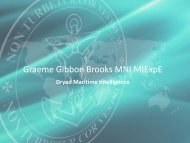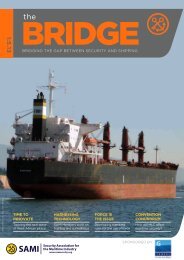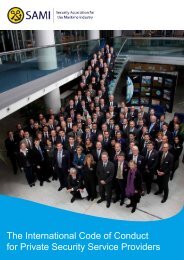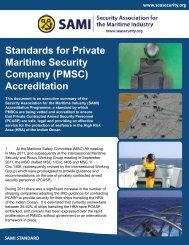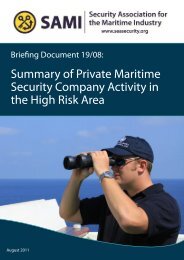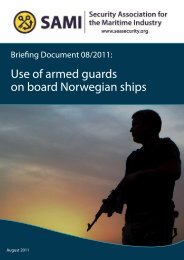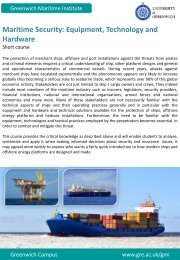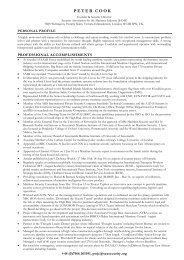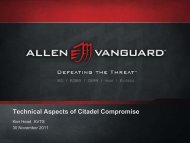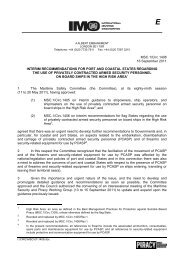SAMI Briefing Maritime Labour Convention FAQs and Text March 2013
SAMI Briefing Maritime Labour Convention FAQs and Text March 2013
SAMI Briefing Maritime Labour Convention FAQs and Text March 2013
You also want an ePaper? Increase the reach of your titles
YUMPU automatically turns print PDFs into web optimized ePapers that Google loves.
C5.2.f. Is there guidance or a model for a port State inspection <strong>and</strong> monitoring system <strong>and</strong> toprovide guidance to authorized officers?The tripartite experts’ meeting in September 2008 adopted the Guidelines for portState control officers carrying out inspections under the <strong>Maritime</strong> <strong>Labour</strong><strong>Convention</strong>, 2006 37 to assist port State control officers to carry out inspections of foreignships coming into their ports [see A14. What is the status of the 2008 ILO Guidelines, forflag State inspections <strong>and</strong> port State control officers?]. The need to develop internationalguidelines <strong>and</strong> related national guidance for port State control officers had, in fact, beenforeseen in the MLC, 2006 itself. The MLC, 2006 begins, in Article I, by requiring that:“Members shall cooperate with each other for the purpose of ensuring the effectiveimplementation <strong>and</strong> enforcement of the <strong>Convention</strong>.” More specifically Regulation 5.2.1,paragraph 3 provides that “Inspections in a port shall be carried out by authorized officersin accordance with the provisions of the Code <strong>and</strong> other applicable internationalarrangements governing port State control inspections in the Member”. St<strong>and</strong>ard A5.2.1,paragraph 7 provides that “Each Member shall ensure that its authorized officers are givenguidance, of the kind indicated in Part B of the Code, as to the kinds of circumstancesjustifying detention of a ship under paragraph 6 of this St<strong>and</strong>ard”. Finally, GuidelineB.5.2.1, paragraph 3 provides that “Members should cooperate with each other to themaximum extent possible in the adoption of internationally agreed guidelines on inspectionpolicies, especially those relating to the circumstances warranting the detention of a ship”.Developing guidelines for port State control officers was an important response to the callfor “internationally agreed guidelines”, in so far as the implementation of the MLC, 2006is concerned. However, a harmonized approach to port State control is an ongoing processthat includes cooperation among countries <strong>and</strong> coordination of maritime inspection underseveral maritime <strong>Convention</strong>s, not just the MLC, 2006 but also, particularly, the relevantIMO <strong>Convention</strong>s.C5.2.g. What is to be inspected during port State control?The purpose of the inspection by PSCOs is to determine whether a ship is incompliance with the requirements of the <strong>Convention</strong> (including seafarers’ rights)(Article IV, paragraph 5). These requirements are laid down in the Articles <strong>and</strong>Regulations <strong>and</strong> in Part A (St<strong>and</strong>ards) of the Code of the MLC, 2006, relating to theworking <strong>and</strong> living conditions of seafarers on the ship (Regulation 5.2.1, paragraphs 1<strong>and</strong> 3). Part B (guidelines) of the MLC, 2006, Code is not subject to inspection by portState control. Port State control inspections are, in principle, concerned with the 14 areasof working <strong>and</strong> living conditions on the ship (St<strong>and</strong>ard A5.2.1, paragraph 2) that are listedin Title 5, Appendix A5-III of the MLC, 2006, <strong>and</strong> are to be certified by flag States asbeing in compliance with the related requirements of the <strong>Convention</strong>. However, the PSCOmay also take action in the case of non-compliance with any other requirement of the<strong>Convention</strong> relating to working <strong>and</strong> living conditions (Regulation 5.2.1, paragraph 1).The details for the implementation of the MLC, 2006 requirements are to beprescribed, in accordance with the <strong>Convention</strong>, in the national laws or regulations,collective agreements or other measures in the flag State concerned. On ships carrying amaritime labour certificate, a summary of the relevant national st<strong>and</strong>ards adopted toimplement the MLC, 2006, in the 14 areas referred to will be set out in Part I of the DMLCattached to the certificate. These 14 areas of flag State certification (listed in Appendix A5-I to the MLC, 2006) are the same as the 14 areas that are in principle to be covered by aport State control inspection (listed in Appendix A5-III). As indicated below, thebe useful for port State authorities to consider (Regulation A5.1.4, paragraphs 2, 3, 6, 7, 10, 11<strong>and</strong> 12).37 See footnote 5.FAQ 49




